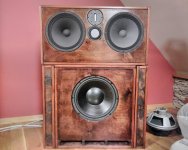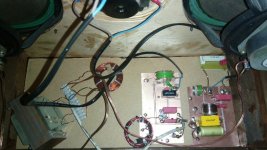I'm a headphone guy so I don't think I fully get what you mean in this respect.So that includes harmonic, phase/group delay/time alignment, modulation, compression distortions.
Did you think about power response/polar coverage in your definition of "distortion"? It happens to be the most important type of distortion in terms of subjective listening, as reported by Sean Olive at JBL/Harman.
Chris
Doesn't DSP solve those kinds of issues?The more crossover points, especially when slopes are steep, the worse overall problem with phase shift/group delay.
But generally, hearing of many people seems to be forgiving in this respect.
If you've listened to multi-way systems with IIR filters and you liked the sound, then you have a lot of crossover solutions to choose from.
The only kind of crossover I would want to use is a software, dsp based crossover.
Yes!Is there an optimal number of crossover points that a speaker system should have in a multi-way system?
Attachments
Doesn't DSP solve those kinds of issues?
The only kind of crossover I would want to use is a software, dsp based crossover.
Of course this is solvable in DSP.
The results will be just a matter of your time devoted to learning, and later on testing.
If you're willing to talk about loudspeakers instead of headphones (no, they're not the same, unfortunately), then you'll find that power response (off-axis) is the most important determinant of sound preferences, as I stated above.
When you use more and more crossover filters, some bad things happen. As mentioned multiple times above, you will have phase/group delay issues and/or time alignment issues--if you're using anything but first order filters.
If you're using FIR filters for crossovers, you will likely run into pre-ringing issues...and latency issues if you try to use the filters at a frequency below 500 Hz--which is where you really need the phase growth control--especially at very low frequencies. Digital filtering is not a panacea for all issues--but having said that, I don't really recommend using passive crossovers, and DSP is the preferred approach IMHO.
The more you find out about loudspeakers versus headphones, you will notice that loudspeaker power response (polar coverage smoothness and consistency) is really your first requirement since you can't correct it by any other means except the driver/horn design (or succession of optimal diameter direct radiating drivers that match their polars at each crossover interference band). This is the real problem with crossovers--matching polars--and secondarily, it's the phase/group delay/time delay issues that the filters themselves impart.
Chris
When you use more and more crossover filters, some bad things happen. As mentioned multiple times above, you will have phase/group delay issues and/or time alignment issues--if you're using anything but first order filters.
If you're using FIR filters for crossovers, you will likely run into pre-ringing issues...and latency issues if you try to use the filters at a frequency below 500 Hz--which is where you really need the phase growth control--especially at very low frequencies. Digital filtering is not a panacea for all issues--but having said that, I don't really recommend using passive crossovers, and DSP is the preferred approach IMHO.
The more you find out about loudspeakers versus headphones, you will notice that loudspeaker power response (polar coverage smoothness and consistency) is really your first requirement since you can't correct it by any other means except the driver/horn design (or succession of optimal diameter direct radiating drivers that match their polars at each crossover interference band). This is the real problem with crossovers--matching polars--and secondarily, it's the phase/group delay/time delay issues that the filters themselves impart.
Chris
Last edited:
The more you find out about loudspeakers versus headphones, you will notice that loudspeaker power response (polar coverage smoothness and consistency) is really your first requirement since you can't correct it by any other means except the driver/horn design (or succession of optimal diameter direct radiating drivers that match their polars at each crossover interference band). This is the real problem with crossovers--matching polars--and secondarily, it's the phase/group delay/time delay issues that the filters themselves impart.
Chris
Funny thing is, when we minimize phase/group delay/time delay issues, the speakers sound more like headphones, and many audiophiles do not like that kind of speakers. I believe this is why Dunlavy shut down their business. He could not sell enough speakers. Most of his customers were mastering studios.
In my experience, average audiophiles do not care messy phase in general. They can hear the phase distortion, but they are already so accustomed to it. Full range guys have noticed this, but they are still minority.
A lot of off topic opinionating on this thread. An ideal crossover would have the two drivers occupying the same space. This isn't necessary (or possible, normally), because it can be accounted for. I can't imagine what you'd mean by an ideal crossover.I'm assuming ideal crossovers.
What is ideal loudspeaker or transducer then? Absurd question really, there are so many different requirements to define and fill. They can be good for the intended purpose at best!
Headphones aren't easy either. Nowdays many manufacturers have two-way models because low distortion for bass and smooth treble are a diffucult combination.
This goes actually down to physics - wavelength, amplitude, sound dispersion, sound reflections in a room, different transducer types and mechanics. Then add neurophysiology and perception of hearing to this. And personal vs. average opinion and preference plus experience, ability hear (recognize) different factors of sound quality.
Lots of good reading here http://seanolive.blogspot.com/
Headphones aren't easy either. Nowdays many manufacturers have two-way models because low distortion for bass and smooth treble are a diffucult combination.
This goes actually down to physics - wavelength, amplitude, sound dispersion, sound reflections in a room, different transducer types and mechanics. Then add neurophysiology and perception of hearing to this. And personal vs. average opinion and preference plus experience, ability hear (recognize) different factors of sound quality.
Lots of good reading here http://seanolive.blogspot.com/
In my experience, average audiophiles do not care messy phase in general. They can hear the phase distortion, but they are already so accustomed to it. Full range guys have noticed this, but they are still minority.
I personally don't consider what is reported by hi-fi magazines as "hi-fi" has got a lot to do with real hi-fi. Rather I believe that there are many audiophile writers and perhaps others that "want it they way that they want it" and are not terribly well versed in the engineering knowledge of high fidelity, acoustics, and psychoacoustics. This is true for almost all popular technical subjects, it seems.
I do believe that John Dunlavy died of complications of dementia (a.k.a., Alzheimer's disease). You implied that he sold his business because of lack of sales due to people really not caring about hi-fi. I don't believe that's accurate. See the link here for a little more information. Mr. Dunlavy was apparently a really good engineer that owned a couple of loudspeaker companies (Duntech, Dunlavy). He also did a couple of very innovative engineering inventions earlier in his career that were classified for a long time, so I don't believe that he got credit for those accomplishments very widely.
Chris
In a nutshell:
- Three way brings you to the concert hall
Goldwood 1858, Fane 6-100 and NdRL ribbon on H-frame and OB, 250 Hz 2nd order and 7500 Hz 3rd order;
- Four and a half way brings you to the recording studio. And makes them sing and play slowly and comprehensively.
Dayton "15 (16.6 Hz resonance) in 240L slot ported bass reflex tuned sub 20Hz, 2x12 on OB, one compensates for the OB roll off through big inductance, TB honeycomb Nd flat driver and a NdRL ribbon, 85 - 4th order, 185 - 1st order, 800 - 2nd order and 8000 Hz - 4th order.
It was hard, but not too hard to make it all work, measures and sounds flat and well, super neutral and realistic. The biggest tweak was splitting the two 12's band into a 1.5 way because of lobbing, before that the big inductance was in a BSC circuit.
OB's only alternative is super wide baffle or in wall.
So, not only, at least 4 way, but also an OB.
Also, flat, flat and again flat and nothing else. EQ if any, only below room threshold 60 to 100 Hz and above 15 kHz to compensate for acoustics and age of listener.
- Three way brings you to the concert hall
Goldwood 1858, Fane 6-100 and NdRL ribbon on H-frame and OB, 250 Hz 2nd order and 7500 Hz 3rd order;
- Four and a half way brings you to the recording studio. And makes them sing and play slowly and comprehensively.
Dayton "15 (16.6 Hz resonance) in 240L slot ported bass reflex tuned sub 20Hz, 2x12 on OB, one compensates for the OB roll off through big inductance, TB honeycomb Nd flat driver and a NdRL ribbon, 85 - 4th order, 185 - 1st order, 800 - 2nd order and 8000 Hz - 4th order.
It was hard, but not too hard to make it all work, measures and sounds flat and well, super neutral and realistic. The biggest tweak was splitting the two 12's band into a 1.5 way because of lobbing, before that the big inductance was in a BSC circuit.
OB's only alternative is super wide baffle or in wall.
So, not only, at least 4 way, but also an OB.
Also, flat, flat and again flat and nothing else. EQ if any, only below room threshold 60 to 100 Hz and above 15 kHz to compensate for acoustics and age of listener.
Last edited:
The only thing I want is accurate reproduction of live sound.
I think you want to discover that for yourself and best to start humbly, than proceed with gradually more complicated systems.
- Four and a half way brings you to the recording studio. And makes them sing and play slowly and comprehensively.
Dayton "15 (16.6 Hz resonance) in 240L slot ported bass reflex tuned sub 20Hz, 2x12 on OB, one compensates for the OB roll off through big inductance, TB honeycomb Nd flat driver and a NdRL ribbon, 85 - 4th order, 185 - 1st order, 800 - 2nd order and 8000 Hz - 4th order.
Not sure how a speaker that does not remotely resemble anything I've ever seen in a studio would 'bring you to the recording studio'.
What would do that is an acoustically well treated room and something along the lines of active ATC speakers.
I do believe that John Dunlavy died of complications of dementia (a.k.a., Alzheimer's disease). You implied that he sold his business because of lack of sales due to people really not caring about hi-fi. I don't believe that's accurate. See the link here for a little more information. Mr. Dunlavy was apparently a really good engineer that owned a couple of loudspeaker companies (Duntech, Dunlavy). He also did a couple of very innovative engineering inventions earlier in his career that were classified for a long time, so I don't believe that he got credit for those accomplishments very widely.
Chris
Thank you for correcting my thought. Anyway, I'm a big fan of his speakers.
Last edited:
The only thing I want is accurate reproduction of live sound.
I wish I know which specific recordings (CD, vinyl, hires streaming) include the accurate reproduction of live sound. I don't have any in my collection.
I do think that everything is about the compromises when we talk about music reproduction. Everyone has different taste and different sensitivity, so you're the only one to know where you can compromise.
So, it's better to know each crossover's weakness, rather than each crossover's strength.
Last edited:
No, my 4.5 way system designed for eliminating the acoustic environment does it. Although the room is not symmetric for the left and right speaker placement, they measure the same at the listening spot. Those are acoustically independant speakers. Anything that is flat, distortion free and reflection free brings you right to the pickups in the studio. 4th order LR@85Hz not shown, also amybe the photo is not of the exact final version of the crossover, but you get it.Not sure how a speaker that does not remotely resemble anything I've ever seen in a studio would 'bring you to the recording studio'.
What would do that is an acoustically well treated room and something along the lines of active ATC speakers.
Attachments
The only thing I want is accurate reproduction of live sound.
Be careful what you wish for Performance characteristics for lifelike reproduction of percussion instruments
If you're exclusively focused on stereo recordings (as many are here), there really aren't very many--less than 0.1% in my experience. Linn Records seems to apply very little EQ and limiting/compression that I can discern. They're within that 0.1% that I was talking about.I wish I know which specific recordings (CD, vinyl, hires streaming) include the accurate reproduction of live sound. I don't have any in my collection.
However, I've found more than a few multichannel discs (5.1) that are pretty close: the only thing that you can point to is the exact locations of the microphones and the mixing process, else there seems to be little or no mastering EQ applied. AIX Records' (among others) multichannel recordings apparently does no processing other than mixing to 5.1 and chopping the music into tracks: that's it--not even limiting/compression is apparently applied. You can hear that absence of processing, too. It's somewhat amazing to hear, in my experience.
Chris
- Status
- This old topic is closed. If you want to reopen this topic, contact a moderator using the "Report Post" button.
- Home
- Loudspeakers
- Multi-Way
- Does more crossovers = better sound?


